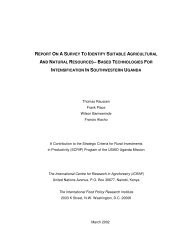Decentralisation in Uganda Rhetoric-Chapter3. - Foodnet
Decentralisation in Uganda Rhetoric-Chapter3. - Foodnet
Decentralisation in Uganda Rhetoric-Chapter3. - Foodnet
You also want an ePaper? Increase the reach of your titles
YUMPU automatically turns print PDFs into web optimized ePapers that Google loves.
Jeremy L<strong>in</strong>d and Jan Cappon<br />
natural resources management are premised on<br />
a belief <strong>in</strong> problem environments and problem<br />
people. ULAMP’s strategy is based on<br />
understand<strong>in</strong>gs of negative environmental<br />
change lead<strong>in</strong>g to a decl<strong>in</strong>e <strong>in</strong> land productivity.<br />
A ULAMP consultant contended that unsusta<strong>in</strong>able<br />
natural resources use is lead<strong>in</strong>g to<br />
significant soil fertility and land productivity<br />
problems. 62 Consultant reports and project assessments<br />
for ULAMP share similar perceptions<br />
of environmental decl<strong>in</strong>e lead<strong>in</strong>g to compromised<br />
farmer livelihoods. 63 Reports and<br />
evaluations for AHI perceive local environments<br />
negatively and conceive of livelihoods<br />
as threatened. An AHI document claimed that<br />
land productivity decl<strong>in</strong>es are apparent <strong>in</strong> the<br />
Kabale region of south-western <strong>Uganda</strong>. Years<br />
of <strong>in</strong>tense cultivation, it expla<strong>in</strong>ed, have left the<br />
land degraded and the forests cleared, result<strong>in</strong>g<br />
<strong>in</strong> biodiversity loss. 64 These assessments of<br />
negative environmental change, however, are<br />
not supported by substantiated ecological evidence.<br />
Degradation arguments are challenged<br />
elsewhere. Farley notes that pollen data collected<br />
from swamp cores at Kabale show that<br />
forest clearance <strong>in</strong> the region occurred from<br />
2200 to 4800 years B.C.E. 65 Ideas about environmental<br />
decl<strong>in</strong>e and alarmist environment<br />
views used to understand farmer livelihoods<br />
serve a strategic purpose. For organizational<br />
strategies that envision “improved” forms of<br />
environmental management, they justify <strong>in</strong>tervention<br />
<strong>in</strong> rural environmental plann<strong>in</strong>g.<br />
People, too, are problematic, as a characterization<br />
report of the south-western <strong>Uganda</strong> environment<br />
argued, “Poor conservation meth-<br />
28<br />
ods of land management have depleted the life<br />
support capacity of the land.” 66 Mak<strong>in</strong>g the case<br />
for gett<strong>in</strong>g local natural resource management<br />
“right” appears to require that prevail<strong>in</strong>g methods<br />
be construed as “wrong”. Local practices<br />
are constructed as a menace; the local attitudes<br />
on which they are shaped are seen as anomalous<br />
to the pr<strong>in</strong>ciples of susta<strong>in</strong>ability use. Participatory<br />
approaches are assumed to be capable<br />
of overcom<strong>in</strong>g these weaknesses, a po<strong>in</strong>t<br />
belaboured <strong>in</strong> an AHI work plan. The workplan<br />
states that “by us<strong>in</strong>g participatory approaches,<br />
farmers should better understand the consequences<br />
of their actions and be able to see the<br />
need to change and adopt beneficial practices.”<br />
67 Chang<strong>in</strong>g attitudes and practices,<br />
therefore, is one precondition for achiev<strong>in</strong>g idealized<br />
environments and livelihoods. Some attitudes<br />
and practices are <strong>in</strong>deed problematic.<br />
But, by what and whose standards are they<br />
judged to be problematic? There are few environmental<br />
attitudes and practices that serve a<br />
common <strong>in</strong>terest. Rather, <strong>in</strong> many cases, they<br />
serve a strategic use for <strong>in</strong>dividuals and groups<br />
barga<strong>in</strong><strong>in</strong>g for differentiated and more favourable<br />
environmental outcomes.<br />
Typically, however, little effort is spent on<br />
discern<strong>in</strong>g between those local attitudes and<br />
practices that are problematic and those that<br />
are beneficial for the susta<strong>in</strong>able management<br />
of natural resources. Determ<strong>in</strong>istic representations<br />
of local natural resources management,<br />
<strong>in</strong>formed exclusively by problematics, ignore<br />
local practices and attitudes beneficial to environments<br />
and livelihoods. A study of tradi-
















